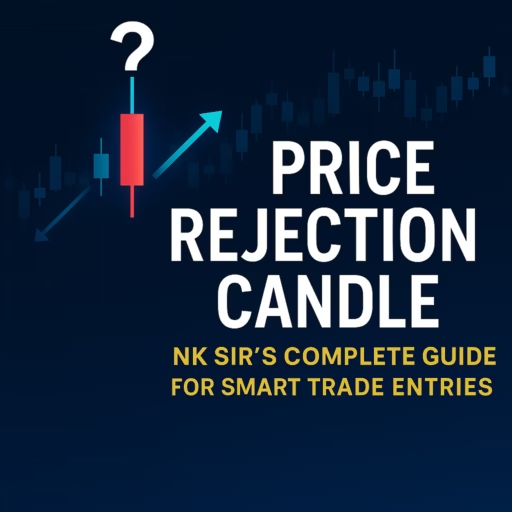Understanding price action is one of the most crucial skills for any trader, and among all candle types, the price rejection candle holds immense value. In one of his insightful videos, trading mentor NK Sir explains how to use price rejection candles to improve trade entries and exits. This blog post expands on his teachings with added structure, examples, and key takeaways — making it a perfect starting point for beginners and a great refresher for experienced traders.
Table of Contents
🔍 What is a Price Rejection Candle?
A price rejection candle is a candlestick that shows the market tried to push the price in one direction but failed to sustain that move. This failure is often indicated by long wicks (also called shadows) and small real bodies. These candles suggest a shift in market sentiment — either buyers rejecting lower prices or sellers rejecting higher ones.
Key characteristics:
- Long upper wick: Sellers rejected higher prices.
- Long lower wick: Buyers rejected lower prices.
- Small body: Shows indecision or a tug-of-war.
- Closes within previous range: Adds more reliability if found near support/resistance.
🔢 Common Types of Price Rejection Candle
1. Pin Bar
One of the most powerful rejection candles. It has a small body and a long wick on one side. A bullish pin bar has a long lower wick; a bearish pin bar has a long upper wick.
2. Doji Candle
Occurs when the open and close prices are nearly identical. It shows indecision but becomes powerful near support/resistance.
3. Hammer & Hanging Man
- Hammer: Appears after a downtrend, with a long lower shadow and small body. Bullish signal.
- Hanging Man: Appears after an uptrend with the same structure. Bearish signal.
4. Inverted Hammer & Shooting Star
- Inverted Hammer: Long upper wick, small body. Appears at the bottom of a trend.
- Shooting Star: Appears at the top of a rally. Long upper wick, small body. Signals potential reversal.
🔬 How to Use Price Rejection Candles in Trading
According to NK Sir, the key to using rejection candles lies in context and confirmation.
Step-by-Step:
- Mark key levels: Draw support/resistance zones before market opens.
- Wait for rejection candles to form at those levels.
- Confirm the setup with additional indicators like RSI or EMA.
- Check volume: High volume adds strength to the signal.
- Enter with discipline: Don’t jump in blindly. Wait for next candle confirmation.
Stop-loss: Just beyond the wick of the rejection candle. Target: Nearest swing high/low or next resistance/support level.
🤔 Mistakes to Avoid
- Trading every doji or wick: Location matters more than the candle itself.
- Ignoring confirmation: Entering without next candle validation is risky.
- Poor risk-reward: Placing SL too close or chasing late entries leads to losses.
- Overtrading: Rejection candles aren’t frequent — wait for quality setups.
🤝 NK Sir’s Key Insights
“Rejection candles are market signals — not trading triggers by themselves. Learn to read them with the full market context.”
- Don’t confuse any wick as rejection. Always ask: Where is it appearing and why?
- Combine with price structure and trend direction.
- Rejection candles near round numbers like 25,000 or 18,000 are more reliable.
- Daily timeframe signals are stronger than lower TFs.
📈 Real-Life Example (Hypothetical)
Imagine Nifty is approaching a key resistance at 25,000. A bearish pin bar forms with a long upper wick and closes below 24,950.
- Entry: Short below the pin bar’s low
- Stop-loss: Above the high of the wick
- Target: 24,800 (previous support zone)
The trade respects rejection logic and delivers high R:R.
🔝 Frequently Asked Questions (FAQ)
Q1. Can I use rejection candles for intraday trading?
Yes — especially on 5min, 15min, or hourly charts. But combine with levels.
Q2. Are they reliable in all markets?
More reliable in index and large-cap stocks due to volume.
Q3. What timeframe is best?
Daily and 1-hour are preferred for clarity and reduced noise.
Q4. Should I wait for the candle to close?
Always! Entry before close can lead to false signals.
🚀 Final Thoughts
Price rejection candles are powerful when used correctly. NK Sir’s simplified teaching helps traders avoid noise and focus on price behavior at critical levels. With patience, context, and discipline, these candles can give excellent trade entries with low risk.
Keep observing, keep learning. Market is the best teacher — and price is the purest language.
Did this guide help you? Share it with fellow traders and let us know your experience with rejection candles in the comments.

